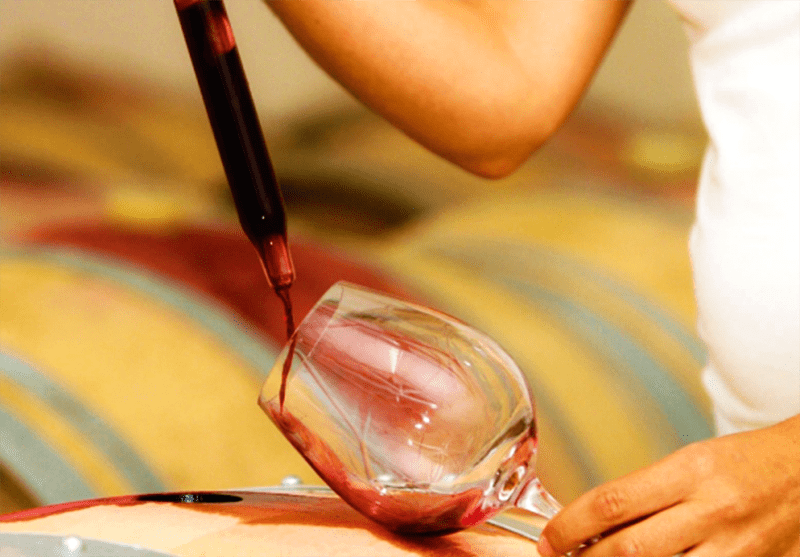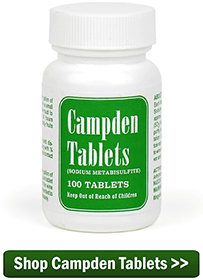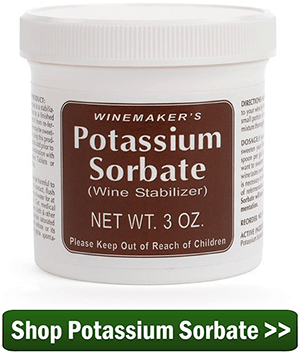 I have tried to make a strawberry wine… I had started the process back on 1/26/20. On 2/28/20 I racked off the wine after it quit working and it had a SG of less than 1. But it tasted really bitter. Is there something that I can do to give it a better strawberry taste or add another fruit. I am open to suggestions, so I don’t have to dump 6 gal of what should be a good flavored wine.
I have tried to make a strawberry wine… I had started the process back on 1/26/20. On 2/28/20 I racked off the wine after it quit working and it had a SG of less than 1. But it tasted really bitter. Is there something that I can do to give it a better strawberry taste or add another fruit. I am open to suggestions, so I don’t have to dump 6 gal of what should be a good flavored wine.
Kevin S. — IL
—–
Hello Kevin,
I’m sure this wine is far from being dumped. You are in the same boat that many other fruit winemakers have been in — that is the fruit wine has no sweetness, therefor it taste nothing like fruit.
Some of the bitterness you are referring to could be from microscopic yeast still floating around. Some of it could be because the wine simply needs some time to maturate and age off its rough edges. Then there’s the fact that the wine is dry. All three of these things will need to be considered when removing the bitterness from any homemade fruit wine.
I would strongly suggest that you age the wine in bulk for a while before trying to make any adjustment or take any corrective action. The reason for this is to make sure all the yeast has had plenty of time to drop out, and also to allow the wine time to take advantage of the benefits of aging. At this stage every 30 days of maturation should add some noticeable improvements.
During this bulk aging it is important that the head-space be eliminated as much as possible. You want the wine exposed to very little oxygen. Not doing so can cause the wine to oxidize. You will also want to add another dose of Campden tablets at this time. This will help drive out any free oxygen that may be saturated in your strawberry wine. It will also destroy any wild microbes that may have floated onto the wine. Campden tablets will make sure these little nasties don’t have a chance to grow and spoil the wine.
Kevin, you want the wine to improve as much as possible before you take steps toward removing the bitterness. The reason for this is twofold: 1) Hopefully, the actions needed after aging will not need to be as drastic if aging has improved it enough. 2) If you try to remove the bitterness now, you may be trying to fix or coverup things in the fruit wine that won’t be there later once it does age in the bottle or wherever. In other words, you might end up over-compensating with too much of a corrective action.
Now that we have that out of the way. The most common thing for removing the bitterness from a homemade fruit wine is sweetening it. One of the fundamental characters of any fruit is sweetness – including strawberry. When you take out all the sweetness through fermentation, it no longer tastes like that fruit.
In my experience, a little bit of back-sweetening can bring out a lot of fruitiness. You don’t necessarily have to add so much sugar as to make the wine sweet, just enough to take the try edge off. It is important that potassium sorbate be added at the same time. This is a wine stabilizer that is added so that a re-fermentation does not occur from the newly added sugars. You can find more information on this process in the article, Making Sweet Wines.
Normally regular, store-bought cane sugar will do just fine for sweetening. It also provides the most predictable results, however there is some room for experimentation by sweetening with honey, corn sugar, fruit concentrates, etc.
By far, aging and sweetening with cane sugar is the most common remedy for a bitter homemade wine. It is all that needs to happen most of the time, but there are situation where it just isn’t enough. The fruitiness still isn’t there or what have you. In these instances experimentation may be necessary.
You can try flavorings to intensify the wine’s flavors. You might also want to experiment with blending the wine with another. Wines that are too high in alcohol tend to have less flavor. The tongue is numbed by the alcohol giving the impression that the wine has no flavor. Dilution with a low alcohol wine could be appropriate.
Regardless of the experimental path you choose, it will be important to test the results on a sample of the wine. Do a bench-test before committing the entire batch. Step cautiously when experimenting with your wine.
My hope is that aging is all that is needed for removing the bitterness from your wine. But just this same I have laid out these additional, more-extensive options, just in case more radical measures are needed.
Best Wishes,
Ed Kraus
—–
Ed Kraus is a 3rd generation home brewer/winemaker and has been an owner of E. C. Kraus since 1999. He has been helping individuals make better wine and beer for over 25 years.

This is a good article. Thanks for sharing.
My experiance with very mild bitterness in fruit wine was hit and miss. I had made strawberry wine for a couple years and just couldn’t figure out why the wines finish was off slighty. One year took a one gallon carboy to a new years party that was held by an experianced winemaker. I left a container in the car for a few hours till the timing was appropriate for tasting and advise for a fix. It was very cold that evening and I noticed the wine was starting to slush. The wine was tasted and was perfect. The bitterness was removed completely and tartrate cystals were not present. It’s not clear to me what physical change had taken place but I continue with this process whenever I encounter this problem.
Paul I make strawberry wines also and have found that degassing the wine a couple of weeks prior to bottling makes the wine have a softer taste. Wondered if you may have tried this. I whip mine with a bent stainless rod and Kraus sells “whippers” also. The purpose of whipping the batch of wine is to remove trapped CO2 gas. Possibly the ice did some of that with your wine.
recently i prepared 4.5 ltr wine.i used table seed black grapes,dry yeast,sugar and potassium metabisulphate.21days stirring+21days seasonig.but it is light bitter taste.how to remove bitterness.
Dr. Rama, first let me say, if the wine is still fermenting or just completed fermentation, it is normal for the wine to not taste good at this point. It is a young wine that can have harsh flavors and needs to age to mellow out. The articles posted below will discus this topic in more detail.
My Wine Is Bitter
http://www.eckraus.com/blog/removing-the-bitterness-from-a-homemade-fruit-wine
http://www.eckraus.com/blog/our-wine-tastes-a-little-bitter-what-should-i-do
I have a 5 gal batch of Muscadine wine that has aged in bulk for 6 months. It had a slight bitter taste and I was very perplexed as what to do about it. I tried your tip of extra sweetening and it worked. Ok tried both cane sugar and honey. Both worked but the honey gave it a a slight exotic touch. Thanks for the tip.
I also have batch of Watermelon going…..(my second try). The first one i tossed out after a year of adjustments. The first time i followed a recipe for 1 gallon… that told me to multiply all ingredients for 5 gallons. ( Mistake ). If you multiply acid blend, it will end up being to much. A good acid tester is important to have. My new batch is doing very well. It is drinkable now, but everyone says…….I don’t taste Watermelon. SO, i added some Wine Conditioner that slightly sweetened it. Knocked some of the edge right off. BUT, you know what. There are alot of wines out there that don’t taste like fruit that they are made from. Some of the best Grape wines in the world don’t taste like grape juice. lol, lol
Are you sure you are talking “bitterness” and not “high acid’? If high acid is what you are tasting, a little (or a lot of) sugar may smooth it out and make it taste OK. If you really have “bitterness” (such as from high tannin in some wines), sugar may not really improve it the same. I think high tannin would be unusual in watermelon wine, unless the recipe called for tannin to be added.
Great article. I made 5 gallons of pumpkin wine during the holidays last year. I followed your directions to the T. It had a beautiful amber color, but it tasted terrible. I put the stopper back on the carboy and put it under the table. After another four months I found the extra time made all the difference it maybe one of the best I’ve made. So I’m going to make it again this year, instead of the raisins I’m thinking about using a white grape juice.
Jere, I have never tried pumpkin wine. It sounds exotic. Can you send me the recipe?
Thanx
Shishir
Me too
I also made a pumpkin wine, and another winemaker in town tasted it and said “I wish I could make wine this good!” (took 1st place at the local show) – tasted like a white wine. My second attempt was nowhere as good, and I threw it out. My third attempt is sitting under the table and I hope the delay removes the bitterness. All three were (I think) the exact same “recipe” (30 litres giant pumpkin diced – so ripe it was almost rotted, some water, 4 cinnamon sticks, 3 whole nutmeg, yeast and nutrient).
I am working on 2 batches of Grapefruit wine, which is my first attempt at making anything. For the first, I used a diluted recipe with a lot of added sugar for 6 gal. For the second, I used straight juice, with a small addition of sugar to bump up the final alcohol percentage for 3 gal. My first batch is 6 months old and tastes pretty good, so I bottled it. The second batch is 5 months old and is not quite right, very bitter. I had added some Bentonite thinking that might help, but it did not do much more than clarify.
I checked with an acid test kit, and batch 1 had about 0.7% Tartaric, while batch 2 had about 1.35. I just added 6 tsp (the kit I used estimated 12, I can always add more later) of Calcium Carbonate to cut the acid and it bubbled like crazy. Hoping that works, it was a lot of work doing all that juicing. Next up is a batch of Pomegranate.
I have had good luck using corn sugar for back-sweetening wine. It dissolves very readily without heating it or a lot of stirring so you don’t have to worry about undissolved sugar in the bottom of the bucket.
I have used both Camden Tablets (CT) and Potassium Sorbate (PS) as needed or when recommended. Always use CT when you are prepared to bottle your wine (any wine); six tablets (or one tab. per-gallon) crushed and diluted in cold water should suffice to “kill the nasties.” Most wine kits will include PS to be added during the de-gassing state, so this additive is generally a requirement which will suffice to improve the wine (dry or sweet).
I have recently made a wine with grapes and raisen using a cold press to extract the juice and putting back the skins for fermentation I also cold pressed juice of orange and lemons
I have added the recommended quantity of sugar today is the seventh day
After tasting it tastes bitter so I added some sugar
But I think maybe cold press juice may be the reason
Please let me know the reason and remedy
Thanks
Shamol
Shamol, if cold pressing over-processes the grapes it can cause the wine to become bitter because of too much tannin in the juice. When crushing grapes for wine making all you want to do is crush them enough to burst the skins. If the source of the bitterness in your wine is due to too much tannin, please take a look at the articles posted below. I would also recommend checking the acid level of the wine to make sure too much acid is not the source of the bitterness.
How To Crush Grapes
https://blog.eckraus.com/how-to-crush-grapes-2
Too Much Tannin
https://blog.eckraus.com/wine-tannin-powder-remover-effects
Does anyone have experience with minimally processed cane sugar: Sucanat. ( It’s not the traditional white granulated cane sugar). It has some molasses. I’d like to try it in making country wines. Any help out there in proportions recommended?
I made strawberry wine and after some sugar and potassium sorbet I added some liquid flavor of kiwi and strawberry mix. You probably carry it at the store. The wine came out wonderful and to me it tasted like liquid cotton candy with a kick. I entered it in a county fair and won first prize. They wanted to send some on a national level but I only had six bottles. Experimenting is always good to learn from.
RHUBARB Wine. Made several batches. Recipe from Mary’s Recipes book. Freezing after wash, cut up, on flat container, in top of freezer goods. package in baggies. Enough for 6 gallons.
One batch, I kept adding sugar, keeping hygrometer reading just above “0”. Got to 22%. Sweetened with liquid sweetner in glass. Took to party. What a blast.
Proper batch @ 12% tastes like sweet grapefruit juice.
Local orchard presses their apples in fall. Took my SS Milk Jug and they filled it up with raw apple cider that has been run over a UV table.
Hi Wayne You seem to know your way around a hydrometer so perhaps you can help me. I make rhubarb, raspberry, blackberry and gooseberry wines and cant make head nor tale of the hydrometer readings. Will all crushed fruit read similar before fermentation and likewise after fermentation. Our wines seem to come mega strong and want to make them less powerful. You mention a figure of zero, so how do you do this. Do you mix in sugar before fermentation till you get to what reading, then ferment and add sugar to get to your zero reading.
Hello Mr. Kraus,
Thanks for this article. I hope you still reply to these emails since I noticed the post was from last year.
I made some blackberry wine this summer – primary fermented it, put it into a carboy for a couple of weeks, then racked it into another carboy and then put it in the dark for four months.
At the recommendation of a winery down the street, I then dissolved sulphite and potassium sorbate into the wine to make sure the fermentation process was complete. After about a day I then added Kielselsol and Chitosan into the wine and stirred it up in order to “clear the wine”, from which I understand is to rid the wine of Tannins? Either way, I let it sit for a couple of weeks and then I racked the wine once into a new carboy, then ran that wine through my mini jet filter. I then sweetened the wine using a conditioner and thought it tasted decent. I then bottled it and after two weeks I tried it and it was very bitter. I waited another two or three weeks and tried another bottle and it was still sharp. I’m not sure what to do at this point in the game. Do I dump it all (5 gallons) into a carboy and do this all again?
Any help would be appreciated.
Thanks!
Jonathan – British Columbia
Jonathan,
Three or four weeks in a bottle is hardly enough time to be concerned. “Bitter/Sharp” characters may remain for months and even years in some cases. I would practice a little patience. Try a bottle after 90 days in the bottle, if it has not mellowed, let’s go 180 days. At this point, sharp and bitter certainly do not indicate there is an infection or oxidation or any reason for concern. I think patience is going to be your best solution;)
Cheers!
Jason
Hi I live in the UK and am having problems with wine bitterness but with gooseberry, blackberry and raspberry wines, do the above cures hold good for all these. Also can you give me an accurate conversion of what a teaspoon is in grams, as I have an assortment of teaspoons some of which are twice as big as others, also recipes never say if it is a level or heaped teaspoon, one recipe gave a converstion of 4.6 grams and then on the same recipe said 6 teaspoons to be used which in brackets said 30.6 grams, which according to my math does not compute, plus some talk about tablespoons, with the same problem, how many grams for a tablespoonfulls.
Sorry I cant buy me ingredients from you but postage would kill me lol